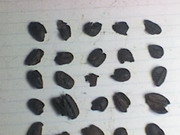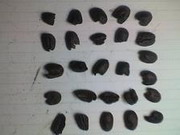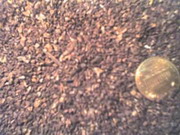|
If your beans pass the "size" test:- there are some "less than scrupulous" people who will spray the freshly roasted beans with water, to speed up the cooling, the roasted beans will absorb some of the water, and give the roaster a nice little increase in the weight of the coffee beans!! If you have got some "dubious" coffee; warm some, gently, in a tightly sealed pan, then leave for a while, and check for any condensation, when the pan has fully cooled; and also check to see if there is any noticeable, weight loss, in the beans, themselves. Pour some of the roast beans on to, a well lit, white surface, and closely examine them: they should all be about the same size, the same colour, and "perfect", insect damage (splits, cracks, or holes) are far more difficult to see after roasting, but with careful examination (a magnifying glass might help) some of them can be spotted. One of the commonest defects, that can be easily seen, is where there is insect damage, at one end of the bean; and the damaged area is darker, and has a slight "spongy" appearance. If there are any really black beans in it, and they appear "withered", indicates very poor (or a total lack of proper) grading. Uneven colour, can indicate that some of the beans were not properly dried, and "damp", a poor roasting method, or that the beans have not been "density separated", the denser beans, roasting slightly more slowly, than the lighter ones. If you can find ANY such defects on your roasted coffee: then it is NOT JBM!!! What an interesting day: shopping day, so crawl out of "the pit" earlier than usual, and see this from my window:-
Get back home, it had been raining on and off, all day: just in time to see the sun set:-
Turn around, and there, is John Crow peak, the top of it, bathed in the red light of the sunset
To try and show you what can be passed off as "coffee", never mind entertaining the thought of giving it the accolade of "drinkable" coffee: I took a short visit to one of our local coffee (???) producers: totally unlicensed, and catering purely for the passing tourist trade (a couple of years ago they were "raided" by the Coffee Board, and had all their equipment, confiscated) and obtained a small (4 ounce) sample of their "Top quality: Blue Mountain Coffee": US$20 per (10% short measure) pound, unless they can get you to pay more for it!! This is exactly the reason for the Coffee Board: to prevent anything even remotely like this, getting exported as Jamaican coffee!!!
Open the pack, and a deep sniff (well: almost knowing what will come out, a very gentle sniff!!) a slight smell of over-roasted, verging on burnt, coffee, in the background, but well overpowered with a smell of rancid chocolate and equally rancid, ground almonds, nothing remotely coffee-like, or pleasant about the odour. First test: the home-made sorting screen (16 screen, 1/4inch) with just a small sample:-
and the rubbish that comes out; undersized beans, broken bits of beans etc. With rubbish like this, just not worth the effort of testing for the water content!! Then, on to the sheet of white paper, and examine the beans:-
With rubbish this bad, no magnifying glass required!! NOT the slightest attempt has been made to grade the coffee, in any way.
Just a few of the reject beans, from the sample I hope you will all appreciate what I forced myself to do, JUST FOR YOU, my readers: I actually brewed some, of this rubbish, and tasted it!!! It was DISGUSTING!!!!! A medium grinding, and no improvement in the smell, as the beans were ground up, the rancid odour increased, and the slight coffee smell, decreased. Brewed in a french press, and left to stand for a couple of minutes: the brew lost any trace of the odour of rancid almonds, just left with a slight odour of burnt coffee, almost totally overpowered by the stink of truly rancid chocolate. The flavour was not quite as bad as the "nose" suggested, it was DEAD, and I mean DEAD, on the palate, hardly a trace of any coffee (just an acidic, burnt, over roasted) flavour, and it left an unpleasant "musty" flavour on the palate, which quickly changed to something akin to rotting vegetable matter, the flavour that you could imagine from the smell of a rotting compost heap, with a slight, but distinct, "metallic", overtone. I then forced myself to take a second taste: slightly more in the way of a coffee flavour, but barely: the rancid chocolate flavour, a little less strong: but the after taste, even worse, and a stronger "compost heap" flavour. The remains of it, straight on to my compost heap (where it would feel, completely "at home") and try to rescue my palate with some mega hot Salsa, on crackers!! Ground coffee. The nose is the best "test equipment" here: very difficult to check visually, but look for any inconsistency in the colour, no lighter or darker bits in it, and the grind should be "even", with little or no oversized bits, or a "powder" at the bottom. Look for light-brown to white bits: if the coffee has not been graded properly there will be lighter coloured bits, and black bits from the insect damaged beans; the better the grading of the coffee, the fewer of these "light and dark" bits will be visible, but even with the very best grading, it is virtually impossible to totally eliminate them. Any more than the "odd" one or two, light or darker bits, and the coffee is "sub-standard".
poor quality; (medium) ground coffee. You can see all the crud in this coffee, the white bits, and even a small bit of a twig(?) I sieved this coffee through a normal, kitchen, flour sieve, and this is what (about a quarter) did not go through the sieve (NOT, I hasten to add, MY coffee, but bought in a local supermarket). This almost looks as though the "floor sweepings" were thrown in with the coffee!! BUT:- there is only one sure test, and that is to brew it: a d-e-e-p breath and fill the nose with the aroma, and then taste it, rolling the nectar all around the mouth, before swallowing; a gentle breath in through the mouth, to get the final part of the flavour: a good JBM will have a perfect balance, no single flavour, or the acidity, overpowering any other, and with a very long lasting, after taste. A flavour that just cannot be fully appreciated, if the brew has been adulterated with additives (milk, creamer, sugar/sweeteners, etc.). Poor quality, or old coffee, will often have a "flat, dead", aroma and flavour, when compared to a "good" coffee. Another problem is that some of the JBM offered for sale, has been bought in our local supermarkets, and shipped abroad in passengers/tourists hand luggage: it IS the real stuff, and is correctly labelled: BUT:- is below the export standards for JBM, and can (should!!) only be sold for "local consumption". Even this, the lowest grades of JBM, is still "a damn fine coffee!", but quite noticeably inferior to the top grades. If you get some JBM, which fails any of these tests, and does not live up to the final and most important test: the cupping: PLEASE report it to the Coffee Board, via the contact page on the web site: and give them as much information, as possible, especially any dates, and batch numbers, that appear on the packet. (keep a sample of the coffee, and the original packaging, as they might request that you send it to them, for further testing) If they discover that the coffee is mislabelled, and illegally using the registered trade marks, and logo: "appropriate" legal action will be taken against the sellers. So, you have checked your coffee against all the information given by the Coffee Board, traced the exporter, and the importer: checked the actual coffee itself, and all is up to specification: and it passes all the tests, even the all important taste test: you have got some REAL, Jamaican Blue Mountain Coffee! ENJOY!!! After all that time and expense, the taste of the "real" stuff, deserves something special for dinner: this is one of my personal favourites, when I have guests. Today's recipe is a "special" from Di "Massa's" table: the plantation slaves, get just the left-overs (if there are any). It is a "fusion" of the 17/18th century European "style" of cooking, with Tropical ingredients. You will need a 2 to 3 pound piece of flank of beef; season one side of it with a well rubbed in mixture of, salt, pepper, a little lemon juice, and finely chopped garlic; cover with thin strips of ham, and thinly sliced carrot, which have been soaked in lemon juice for 5 minutes: sprinkle with a little (preferably, brown) sugar, and dot with several small knobs of butter: tightly roll up the beef, and securely tie with string. Mix up 1 cup of red wine vinegar, with 3 cups of red wine, and pour over the rolled meat, allow to stand for about 30 minutes, rolling the meat several times, in the marinade to ensure even coverage. Drain the marinade, and brown the outside of the meat, in a hot pan, with a little oil (nothing tastes better, if you can get it, than virgin coconut oil), add the marinade, a bay leaf, a whole, small chilli pepper, a piece of crushed ginger root, a chopped onion, a large chopped clove of garlic, a little salt and pepper, chopped red and green peppers, chopped tomatoes, mixed, sweet herbs, and a pinch of ground Pimento: cover tightly, and SLOWLY simmer, turning, and basting the meat with the sauce, several times during the cooking. You will need to add a little water (or any remains of the red wine, if it "survives" the chefs' samplings!!) occasionally, during the cooking, which should take about 3 hours. When cooked, and the meat is really tender, remove the chilli pepper, ginger, and bay leaf; turn up the heat, and thicken the sauce, with a little cornflour: allow the meat to rest for about 10 minutes, serve in slices, and pour the sauce over the slices. Garlic bread (for dunking in the sauce) goes really well with this dish: I like to serve the sliced meat on a bed of English style, mashed potatoes (NOT creamed potatoes): peel and slice (half inch thick) the potatoes: boil, with a little salt, until they are "almost" cooked: drain, and add a small, very finely chopped, onion, a good knob of butter, and a little black pepper, then gently mash them: do NOT add any milk, or other liquid: the result should be a light, dry and fluffy, mash: leave on a very low heat (a steamer, is ideal) for a few minutes, allowing the onion to cook in the retained heat. Put into a preheated serving dish, and sprinkle with some Parsley. AND, of course, followed by a cup of (now you know how to verify it as the REAL!!!) "nectar"!! Until next time, and how we process the coffee, here, on my plantation. Robin Plough, friend of www.coffee4dummies.com For questions about JBM, mail to: Этот e-mail адрес защищен от спам-ботов, для его просмотра у Вас должен быть включен Javascript |
Assessing your coffee (part 3)
Assessing your coffee (part 3)


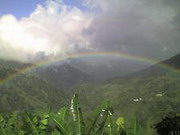
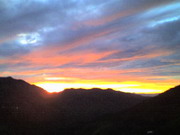
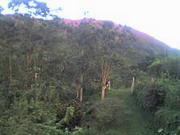
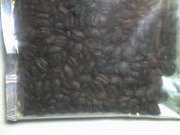 Comes in a proper packet, vacuum sealed.
Comes in a proper packet, vacuum sealed.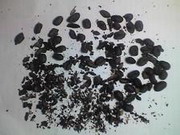
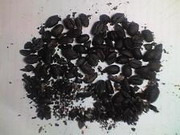
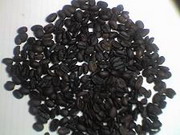 and start separating the undamaged beans from the rubbish beans
and start separating the undamaged beans from the rubbish beans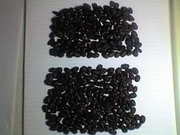 the sample splits into ok looking beans, 45:55 and reject beans
the sample splits into ok looking beans, 45:55 and reject beans